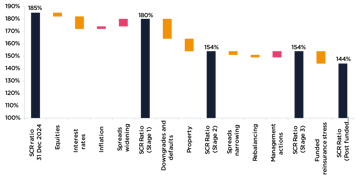What trustees and sponsors need to know about Bank of England life insurer stress test results
This content is AI generated, click here to find out more about Transpose™.
For terms of use click here.

Bank of England life insurer stress test results shows strong financial resilience of bulk annuity market.
The Bank of England has published the aggregate results from its life insurance stress testing exercise providing the market-wide view of how the solvency position of major UK insurers – particularly those active in the bulk annuity market – would be impacted by a severe and persistent financial market shock, and how they might respond.
The Bank of England published the firm-level results one week later, giving greater transparency over the outcomes across the individual participating insurers.
What is LIST 2025?
The Life Insurance Stress Test (LIST 2025) is an exercise run by the Bank of England’s Prudential Regulation Authority (PRA) to assess the resilience of the UK bulk purchase annuity (BPA) insurers. The results of the last stress test, LIST 2022, were published in January 2023.
The 2025 test illustrates how a severe and persistent financial market stress would impact insurers’ solvency, and asset portfolios over a period of time. It covers the eight established insurers in the bulk purchase annuity (BPA) market ie providing buy-ins and buy-outs for DB pension schemes. Only the newest bulk annuity insurers are excluded (Blumont, Royal London and Utmost) with Scottish Widows, a recent exit, also included and two insurers have two entities in scope (Aviva and Just).
Why is LIST 2025 important for pension trustees and sponsors?
For pension schemes that have already completed buy-ins, or are considering transactions, the results offer an independent and directly comparable view of how the major buy-in providers could withstand and respond to a severe but plausible market stress.
The results provide additional data to help trustees and sponsors understand the financial strength, exposure and resilience of buy-in provider(s) or a potential counterparty for an upcoming transaction. This new data point adds to the existing metrics and indicators in the public domain including regulatory capital ratios and credit ratings.
LIST 2025 also examines some of the key areas of insurer solvency that have come under external scrutiny including exposure to Funded Reinsurance (FundedRe) and how the Matching Adjustment operates under a market stress scenario.
What do the results show?
The results show the aggregate Solvency Capital Requirement (SCR) ratio falling from 185% pre-stress to 154% after all elements of the core scenario have played out, a drop of 31%. This is a material reduction in the capital coverage, reflecting the severity of the stress, but the aggregate post-stress position is well above the regulatory minimum of 100% giving policyholders comfort that the sector is well capitalised. The most material impacts in the stress test related to credit downgrades, credit spreads, interest rates and property prices.
Solvency Capital Requirement (SCR) ratio

The overall results indicate there is significant resilience across the sector to financial market stress. The PRA also notes that no individual insurer’s SCR ratio fell below 100% of capital requirements at any stage of the stress – another important comfort for insurance stakeholders, and something we will get more insight into when firm results are published next week. The impact of the stress is likely to vary significantly between firms, reflecting differences in business diversification, asset mix, capital management strategies, hedging and reinsurance. There is also significant variance in the insurers’ solvency ratios at 31 December 2024 (between 144% and 264%), which will be a key factor in the level of solvency coverage the insurers are able to maintain through the stress.
This shows a stronger position than LIST 2022 (which showed aggregate SCR ratios falling from 162% to 123% (a reduction of 39%) and two insurers’ SCR ratios falling below 100%). However, the market stresses applied for LIST 2022 were different and also included a severe longevity stress which LIST 2025 does not.
Funded Reinsurance results
The aggregate results included an exploratory scenario to further stress the insurers with the default of their largest FundedRe counterparty, following on from the core market stress. FundedRe has been a particular focus of the PRA over recent years – see our recent blog here.
As not all insurers make use of FundedRe, this stress will have varied significantly across the insurers, but on aggregate it resulted in a further 10% reduction in SCR ratio to 144%. Unfortunately individual insurer results for this scenario will not be released, however we do take some comfort from the relatively limited impact such a stress would have across the broader market.
Understanding how an individual insurer makes use of FundedRe and manages the associated risks can be a component of insurer due diligence.
What happens next?
The LIST 2025 results represent the aggregate market position and, separately, firm-level results, which give greater transparency over the outcomes across the participating insurers. We expect some insurers to issue their own accompanying commentary to add additional context to the LIST 2025 disclosures.
Trustees and sponsors with an existing buy-in or undertaking a buy-in process may wish to consider seeking a specialist financial review to better understand the implications of the stress results for their selected insurer. This should cover both relevant firm-level data and any accompanying disclosures to understand the relative positioning of their chosen or prospective buy-in providers.
If you want to find out more about LIST 2025 or undertake a specialist review then please speak to your normal LCP adviser or get in touch
Contact usSubscribe to our thinking
Get relevant insights, leading perspectives and event invitations delivered right to your inbox.
Get started to select your preferences.



